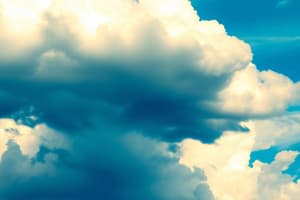Podcast
Questions and Answers
What happens when the air reaches the dew point?
What happens when the air reaches the dew point?
- The humidity decreases rapidly.
- The air temperature increases significantly.
- The air becomes saturated with water vapor. (correct)
- The air is completely dry.
Which of the following best describes humidity?
Which of the following best describes humidity?
- The temperature of the air.
- The amount of water vapor in the air. (correct)
- The measure of atmospheric pressure.
- The amount of ice in the air.
How does the greenhouse effect contribute positively to Earth?
How does the greenhouse effect contribute positively to Earth?
- It cools the planet significantly.
- It creates natural disasters.
- It allows life to exist by keeping the planet warm. (correct)
- It prevents all forms of pollution.
Which form of precipitation can occur when moisture in the atmosphere condenses and falls to the ground?
Which form of precipitation can occur when moisture in the atmosphere condenses and falls to the ground?
Which of the following is a consequence of increased greenhouse gases due to human activities?
Which of the following is a consequence of increased greenhouse gases due to human activities?
What state of water exists when energy is absorbed and reaches a temperature of 0°C or below?
What state of water exists when energy is absorbed and reaches a temperature of 0°C or below?
Which of the following factors determines the moisture content in a substance?
Which of the following factors determines the moisture content in a substance?
In which of the following forms does water NOT exist in the atmosphere?
In which of the following forms does water NOT exist in the atmosphere?
How much water vapor is present in 1 kg of air at 25°C with a relative humidity of 50%?
How much water vapor is present in 1 kg of air at 25°C with a relative humidity of 50%?
By how much °C should 1 kg of air at 25°C cool down to become saturated if the current water vapor content is 14g?
By how much °C should 1 kg of air at 25°C cool down to become saturated if the current water vapor content is 14g?
What process causes the formation of clouds due to air expansion and cooling?
What process causes the formation of clouds due to air expansion and cooling?
Which type of cloud is characterized by its layer-like appearance?
Which type of cloud is characterized by its layer-like appearance?
What describes the rate at which dry unsaturated air cools?
What describes the rate at which dry unsaturated air cools?
Which of the following defines the coalescence process in precipitation?
Which of the following defines the coalescence process in precipitation?
What is the process called when molecules of liquid release energy and turn into a gas?
What is the process called when molecules of liquid release energy and turn into a gas?
Which phase change takes place when solid water (ice) directly transforms into gas?
Which phase change takes place when solid water (ice) directly transforms into gas?
Which cloud type is associated with the highest altitude?
Which cloud type is associated with the highest altitude?
What device is used to measure the amount of moisture (water vapor) in air?
What device is used to measure the amount of moisture (water vapor) in air?
What is defined as any form of moisture that falls from air to the earth?
What is defined as any form of moisture that falls from air to the earth?
What term describes the temperature at which the rate of evaporation and condensation of water is equal?
What term describes the temperature at which the rate of evaporation and condensation of water is equal?
What is the relative humidity if 1 kg of air at 25°C contains 18 g of water vapor?
What is the relative humidity if 1 kg of air at 25°C contains 18 g of water vapor?
How many grams of water vapor are needed to saturate 1 kg of air at 25°C?
How many grams of water vapor are needed to saturate 1 kg of air at 25°C?
If the relative humidity of 1 kg of air at 25°C is 20%, how much water vapor is present?
If the relative humidity of 1 kg of air at 25°C is 20%, how much water vapor is present?
During which phase change does the water vapor transition directly to solid, releasing energy?
During which phase change does the water vapor transition directly to solid, releasing energy?
Flashcards
Humidity
Humidity
The amount of water vapor in the air.
Dew Point
Dew Point
The temperature at which air becomes saturated with water vapor.
Moisture
Moisture
Water in liquid form or traces of water in a substance.
Greenhouse gases
Greenhouse gases
Signup and view all the flashcards
Greenhouse effect
Greenhouse effect
Signup and view all the flashcards
Positive side of greenhouse effect
Positive side of greenhouse effect
Signup and view all the flashcards
Negative side of greenhouse effect
Negative side of greenhouse effect
Signup and view all the flashcards
Water phases
Water phases
Signup and view all the flashcards
Evaporation
Evaporation
Signup and view all the flashcards
Condensation
Condensation
Signup and view all the flashcards
Melting
Melting
Signup and view all the flashcards
Freezing
Freezing
Signup and view all the flashcards
Sublimation
Sublimation
Signup and view all the flashcards
Deposition
Deposition
Signup and view all the flashcards
Relative Humidity
Relative Humidity
Signup and view all the flashcards
Cloud Formation
Cloud Formation
Signup and view all the flashcards
Adiabatic Cooling
Adiabatic Cooling
Signup and view all the flashcards
Dry Adiabatic Rate
Dry Adiabatic Rate
Signup and view all the flashcards
Wet Adiabatic Rate
Wet Adiabatic Rate
Signup and view all the flashcards
Precipitation
Precipitation
Signup and view all the flashcards
Coalescence
Coalescence
Signup and view all the flashcards
Supercooling
Supercooling
Signup and view all the flashcards
Study Notes
Unit IV: Moisture, Clouds, Precipitation, Air Pressure, and Wind
- This unit covers the subjects of moisture, clouds, precipitation, air pressure, and wind.
Lesson 17: Moisture, Cloud Formation, and Precipitation
- Learning Objectives:
- Explain how water changes in the atmosphere and how it is measured.
- Describe how clouds are formed.
- Identify various forms of precipitation.
Task 1: Recall Time
-
Greenhouse Gases and Sources:
- Carbon dioxide
- Methane
- Nitrous oxide
- Water vapor
- Ozone
- Fluorinated gas
-
Benefits of Greenhouse Effect:
- Keeps the planet warm enough for life to exist.
- Without it, Earth would be frozen and uninhabitable.
-
Harmful Effects of Greenhouse Effect:
- Human activities (like burning fossil fuels) increase the amount of greenhouse gases in the atmosphere.
- This makes the greenhouse effect stronger.
Task 2: 4 Pic 1 Word
- Humidity:
- The amount of water vapor in the air.
- High humidity makes it feel wetter outside.
Humidity Calculation
-
Absolute Humidity:
- Measures the amount of water vapor in a parcel of air.
- Calculated as mass of water vapor (in grams) divided by volume of air (in cubic meters).
-
Mixing Ratio:
- Calculated as the mass of water vapor divided by the mass of dry air.
-
Relative Humidity:
- Ratio of actual water vapor content compared to the amount required for saturation.
- Calculated as (amount of water vapor in air / amount of water vapor needed to reach saturation) x 100
Cloud Formation
- Clouds form through adiabatic cooling of water vapor.
Precipitation
- Precipitation: Any form of moisture that falls from air to Earth.
- Coalescence: Water droplets combine to form larger droplets, leading to precipitation.
- Supercooling: Ice crystals form due to freezing nuclei.
- Types of Precipitation:
- Rain (liquid)
- Snow (ice crystals)
- Sleet (frozen rain)
- Hail (large ice pellets)
Studying That Suits You
Use AI to generate personalized quizzes and flashcards to suit your learning preferences.



